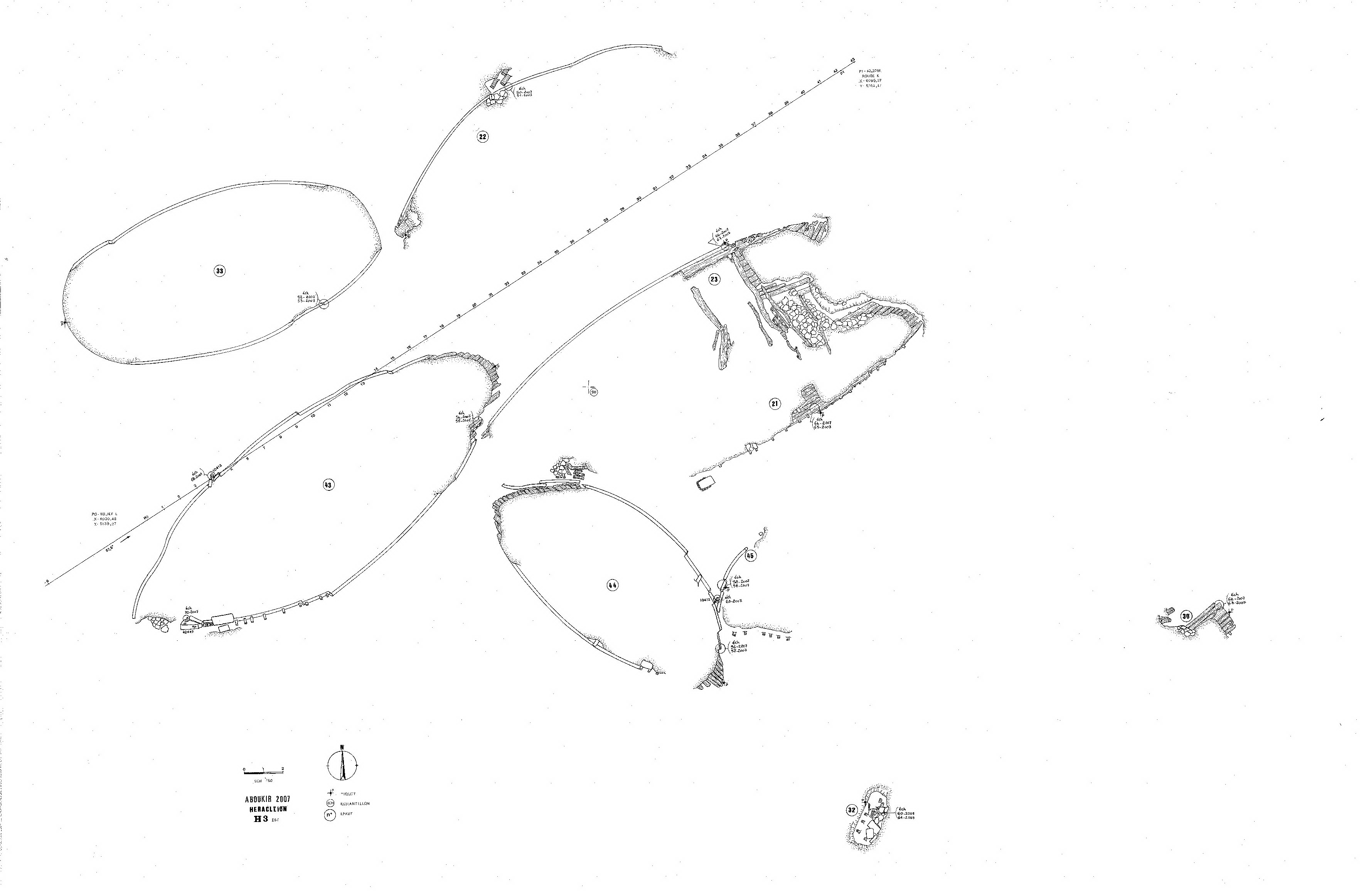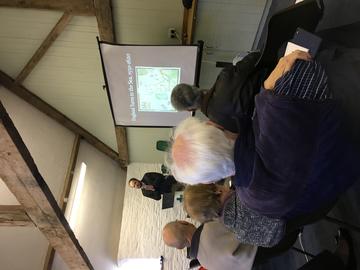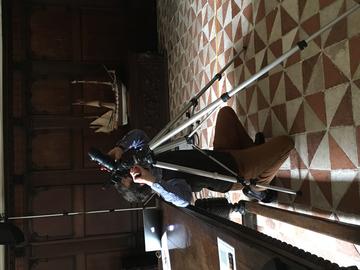Research
The shipwreck J3 was discovered by the IEASM in the Eastern harbour of Alexandria (Portus Magnus) in 2017 and completely excavated the next year. This was a small Roman boat some 6 m long that was well preserved in the sandy sediments at the depth of about eight metres. The port side of the ship was preserved completely, including two thwarts, a guard rail and three thole pins. The ship was flat-bottomed and had a keel. The surviving keel of shipwreck J3 was 4.4 m long while its stem was missing. The keel was rectangular in section and had no rabbet. In the middle of the hull, six lines of strakes were preserved on the starboard of shipwreck J3 and fourteen strakes on the port. The construction of the boat demonstrates a well-developed internal structure with 21 frames preserved. The carvel planking of the ship was assembled with mortise-and-tenon joints cut in the middle of the planks’ edges. The boat had a mast as evidenced by a mast-step and remains of the rigging. A wide choice of wood species was used in the construction. Transom aft, dating, and the size of the ship allows considering it as the horeia-type of a boat which is known both from iconography and the shipwrecks from Toulon and Napoli. Like those, the ship dates to the first century AD as per the ceramic assemblage in context. The interesting aspect of the ship is that it was transporting a large iron anchor the moment it sank. The anchor occupied almost the entire preserved length of the ship and it was carefully positioned on the decked aft area and under the removable thwarts. The small size of the wreck allowed completely excavating it in one season and to perform numerous sections to reveal the details of its internal construction. The shipwreck brings more information on the construction of the horeia-type boats and their implementation in the activities of the Portus Magnus of Alexandria.

Christoph Gerigk © Franck Goddio/Hilti Foundation
In 2011, a team from the Oxford Centre for Maritime Archaeology and the National Museum of the Philippines, supported by the IEASM during their annual mission to Aboukir Bay, began to excavate shipwreck 43, a vessel found in the northern section of the Central Harbour of Thonis-Heracleion. The wreck is one of at least 64 ancient shipwrecks discovered during Franck Goddio’s on-going survey and excavations at the port-city. Upon discovery in 2007, the upper layers of sand around the surviving edges of the wreck had been removed by a team from the IEASM from the surviving edges of shipwreck 43 and the outline mapped. Wood samples were also taken for wood species analysis and radiocarbon dating. Subsequent analyses demonstrates that the structural elements of the wreck were found to be made from locally-available Acacia totilis/radiana, suggesting that the vessel was Egyptian in origin The ship is tentatively dated between 785 and 481 cal. BC.
During the 2011 excavation season, the OCMA team aimed to investigate the wreck through limited stratigraphic excavation in order to understand the sequence of deposition, to assess the state of preservation of the shipwreck, and to document any remaining structural elements. From our preliminary excavations at the stern of the vessel, it would appear that it has a distinctive form of naval architecture involving the use of long tenons that were initially fitted to mortise holes that passed through the keel plank, over which multiple lines of planking were added. These were pegged into place with wooden treenails.
From the albeit limited excavations, there do not appear to be any frames and consequently the long tenons may have provided the structural stability of the vessel through a kind of ‘internal framework’. This probably reflects a shipbuilding tradition that developed in accordance with the availability of local supplies of timber and the realities of nautical life at the margins of the Nile Delta.
The excavations also revealed something of the life of the ship following its withdrawal from service and it appears that the vessel was reused in antiquity for a purpose that is, at present, enigmatic. Hypotheses under consideration include the use of the vessel as part of a type of ‘pontoon bridge’ and the deliberate fastening in position for defence or land-reclamation purposes. A stone anchor, found complete with its wooden flukes, was recovered adjacent to the stem plank.
This work is supported by grants from the Honor Frost Foundation.
Publications
2015. Robinson, D. and Goddio, F. ‘Ship 43 and the graveyard in Thonis-Heracleion’, in D. Robinson and F. Goddio (eds), Thonis-Heracleion in Context. Oxford Centre for Maritime Archaeology Monograph 8: 211–25. Oxford: OCMA.
2011. Fabre, D. ‘The Shipwrecks of Heracleion-Thonis: A Preliminary Study’, in D. Robinson and A. Wilson (eds) Maritime Archaeology and Ancient Trade in the Mediterranean. Oxford Centre for Maritime Archaeology Monograph 6: 13–32. Oxford: OCMA
http://honorfrostfoundation.org/index.php/dr-damian-robinson-ship-43-from-heracleion-thonis/
http://honorfrostfoundation.org/wp/wp-content/uploads/2015/04/Robins on-HFF-report-Ship-43-2014.pdf

P. Sandrin © Franck Goddio/Hilti Foundation
At the western end of a major waterway in the port-city of Thonis-Heracleion, Egypt, the l’Institut Européen d’Archéologie Sous-Marine (IEASM) discovered a small boat. Excavated in 2010, it is currently being prepared for publication at the Oxford Centre for Maritime Archaeology (OCMA), with the nautical architecture being analysed by Carlos Cabrera Tejedor. The vessel has a crescentic shape with a flat-bottomed hull that was constructed from Sycamore Fig planking. This was assembled using mortise-and-tenon joinery with frames secured to the planking using double-clenched copper alloy nails. Preliminary analyses of the vessel form, context of its deposition, and the objects discovered around it, suggest that ship 11 may be the remains of a sacred barque associated with the god Osiris. The vessel had seen a lifetime of work in and around the waterways of the port-city as here, as elsewhere in Egypt, the boat was at the functional heart of religious festivals and activities that were adapted to the local environment. Ship 11 was carefully abandoned at a propitious liminal location within the sacred geography of the city, articulated with the temples, shrines and waterways, and surrounded by a range of objects clearly placed into the water as part of acts of temple and everyday ritual.
Some preliminary discussion of ship 11 can be found in:
Robinson, D. 2018 ‘The depositional contexts of the ships from Thonis-Heracleion, Egypt’ International Journal of Nautical Archaeology 47(2): 325–36.
https://doi.org/10.1111/1095-9270.12321
Goddio, F., 2015 ‘The sacred topography of Thonis‐Heracleion’, in D. Robinson and F. Goddio (eds), Thonis‐Heracleion in Context: 15–54. Oxford.
Goddio, F. and Fabre, D., 2015 Egypt's Sunken Mysteries. Paris.

Christoph Gerigk © Franck Goddio/Hilti Foundation
The Western Marmarica Coastal Survey (2008–2010) covered a region between Mara Lukk and Kambut, east of Tobruk in Libya. This area was viewed as a marginal area, an area to be passed through on the way to the major centres of Cyrenaica and the Egyptian delta. However, semi-arid areas such as these are sensitive indicators of the economic and political health of the state, from the Ptolemaic through the Late Antique periods: where governance is strong, then military and economic infrastructures will be present; where it is weak, they will decline. In the Late Roman period, agricultural produce was transported in locally-made amphora, some of Egyptian type, and in return a wide range of eastern Mediterranean fine wares, glass, and even fragments of Egyptian granite, porphyry and cippolino marble were acquired. The survey identified a progression from settlements oriented towards the sea in the earliest period to a more complex hierarchy of settlements linked connected by road as well as by sea.This depended upon good relations between nomadic and settled groups. In addition, the survey recovered evidence of early activity in the region, from the Middle Stone Age and particular the Libyco-Capsian and Neolithic periods. Nomadic activity is visible in a range of burials, the presence of Libyan Desert ware and knapped glass and rock art.
The final publication is in preparation.
Publications
2010. Hulin, L., Timby, J., Muftah, A.M. and Mutri, G. ‘Western Marmarica Coastal Survey 2010: preliminary report’, Libyan Studies 41: 155–62.
2009. Hulin, L. ‘Western Marmarica Coastal Survey 2009: preliminary report’, Libyan Studies 40: 95–103.
2008. Hulin, L. ‘Western Marmarica Coastal Survey 2008: a preliminary report’, Libyan Studies 39: 299–314.
2008. Hulin, L. ‘Western Marmarica Coastal Survey 2008’, PAST 60 (November).

© Linda Hulin; object photos © Ian Cartwright, School of Archaeology
A Knowledge Exchange project between OCMA and the National Trust (Buckland Abbey and Shugborough Hall)
PI: Linda Hulin and Helena Hamerow
Knowledge Exchange Fellow: Julia Farguson
This six-month project was funded by a Social Sciences Knowledge Exchange Fellowship—Business and Industry 2018–2019. It aimed to develop maritime narratives at National Trust properties with a connection to the sea and in so doing to apply an archaeological perspective to object worlds. Two properties were chosen with the permission of the National Trust: Buckland Abbey, home to Sir Francis Drake and Shugborough Hall, family seat of the Anson family. Buckland Abbey, a Cistercian monastery founded in 1248, was sold by Henry VIII to Sir Roger Grenville, captain of the ill-fated Mary Rose, which sank in Portsmouth Harbour in 1545. The property was eventually acquired by the privateer Sir Francis Drake the first Englishman to circumnavigate the world, 1570–1575. Shugborough Hall was the family seat of the Anson family and home to Thomas Anson, a founder member of the Society of Dilettanti. His younger brother, Admiral George Anson was the second Englishman to circumnavigate the globe, 1740–1744. During that voyage, Admiral Anson captured the Manila galleon the Nuestra Señora de Covadonga, securing the family fortunes. Thomas Anson was able to develop the house and its collections and celebrate the achievements of his brother, who predeceased him.
The project organised a workshop at each house. Admirals and their Families took place at Shugborough Hall on 7 January 2017 and Heroes and Heritage at Buckland Abbey on 28 May 2017. A key legacy of both workshops is that each property now has access to a network of academic and curatorial experts on the maritime world with members willing and able to offer advice to the Trust on future projects. The workshop at Buckland Abbey was especially successful in terms of providing fresh content for new narratives at the house and conversations on how to take this forward are already taking place.
The project provided content to allow the curators (Alison Cooper & Sarah Kay) to develop and promote the maritime narratives at Buckland Abbey and Shugborough Hall in the future and arranged a programme of invited speakers to train docents in the new narratives and provided materials (podcasts) for future training of new volunteers.

One of 4 swivel guns discovered in a storeroom at Shugborough Abbey by one of the docents. These are now being prepared for publication by Damian Robinson. Photo: Ian Cartwright © School of Archaeology, University of Oxford.

Dr James Davey, University of Exeter, speaking to docents at Buckland Abbey. Photo: J. Farguson

Ian Cartwright, Archaeological photographer in the School of Archaeology, University of Oxford, re-photographing plaster work in the Great Hall at Buckland Abbey. Photo: J. Farguson



